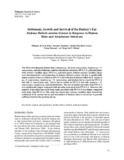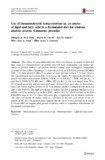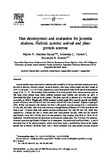| dc.contributor.author | Villa-Franco, Annie | |
| dc.contributor.author | de la Peña, Milagros R. | |
| dc.contributor.author | Nievales, Marie | |
| dc.date.accessioned | 2022-06-06T03:40:11Z | |
| dc.date.available | 2022-06-06T03:40:11Z | |
| dc.date.issued | 2022-06-03 | |
| dc.identifier.citation | Villa-Franco, A. U., dela Peña, M. R., & Nievales, M. F. J. (2022). Grazing periodicity, grazing rate, feeding preference, and gut examination of early juveniles of abalone Haliotis asinina–fed five benthic diatom species. Aquaculture International, 30(5), 2343–2364. https://doi.org/10.1007/s10499-022-00906-7 | en |
| dc.identifier.issn | 0967-6120 | |
| dc.identifier.uri | http://hdl.handle.net/10862/6329 | |
| dc.description.abstract | This study evaluated the suitability of five diatom species (Amphora sp., Cocconeis sp., Navicula ramosissima, Nitzschia sp., and Tryblionella sp.) as food to abalone Haliotis asinina early juveniles (5-mm shell length). Grazing periodicity, grazing rate, and feeding preference were measured; at the same time, abalone gut content was examined. Grazing incidence appeared to be continuous with significantly higher grazing intensity observed at nighttime from 6 p.m. to 10 p.m. (79%) than at daytime from 10 a.m. to 2 p.m. (40%) (p < 0.05). Grazing rates from 6 p.m. to 10 p.m. were significantly higher on N. ramosissima (1.6 × 105) among diatom species but was not statistically different from Cocconeis sp. (1.1 × 105) (p > 0.05). Broken cells of Amphora sp. (22%) were significantly higher in the gut of H. asinina compared to Cocconeis sp. (2.8%), N. ramosissima, (1.8%), and Tryblionella sp. (0.2%) although the abundance of Nitzschia sp. (6%) was not significantly different from Amphora sp. (p > 0.05). Early juveniles showed significant preference for Cocconeis sp. (18.6%), followed by Nitzschia sp. (16.2%), N. ramosissima (13.9%), and Amphora sp. (13.4%), with the least preference for Tryblionella sp. (7.8%). Survival of H. asinina was similar in 4 diatom species (46–71%) except in Tryblionella sp. (8–12%). These findings suggest that diatom species Cocconeis sp., Nitzschia sp., Amphora sp., and N. ramosissima are the suitable live food for H. asinina early juveniles. Knowledge from this study would contribute to the development of a feeding protocol that would maximize production of H. asinina early juveniles in the hatchery. | en |
| dc.description.sponsorship | The Department of Science and Technology—Philippine Council for Agriculture and the Natural Resources Research and Development funded this study under the National Abalone Program of the Philippines, project on refinement of hatchery technology for the donkey’s ear abalone (Study code: NR04-M2009T), with the Aquaculture Department of the Southeast Asian Fisheries Development (SEAFDEC/AQD) as implementing agency. | en |
| dc.language.iso | en | en |
| dc.publisher | Springer | en |
| dc.subject | Haliotis asinina | en |
| dc.title | Grazing periodicity, grazing rate, feeding preference, and gut examination of early juveniles of abalone Haliotis asinina–fed five benthic diatom species | en |
| dc.type | Article | en |
| dc.citation.volume | 30 | |
| dc.citation.issue | 5 | |
| dc.citation.spage | 2343 | |
| dc.citation.epage | 2364 | |
| dc.citation.journalTitle | Aquaculture International | en |
| dc.subject.asfa | abalone culture | en |
| dc.subject.asfa | grazing | en |
| dc.subject.asfa | periodicity | en |
| dc.subject.asfa | feeding preferences | en |
| dc.subject.asfa | juveniles | en |
| dc.identifier.essn | 1573-143X | |
| dc.identifier.doi | 10.1007/s10499-022-00906-7 | |
| dc.subject.scientificName | Haliotis asinina | en |
| dc.subject.scientificName | Amphora | en |
| dc.subject.scientificName | Cocconeis | en |
| dc.subject.scientificName | Navicula ramosissima | en |
| dc.subject.scientificName | Nitzschia | en |
| dc.subject.scientificName | Tryblionella | en |
| local.subject | Benthic diatoms | en |
| local.subject | Early juvenile abalone | en |
| local.subject | Feeding periodicity | en |
| local.subject | Feeding preference | en |
| local.subject | Grazing rates | en |



